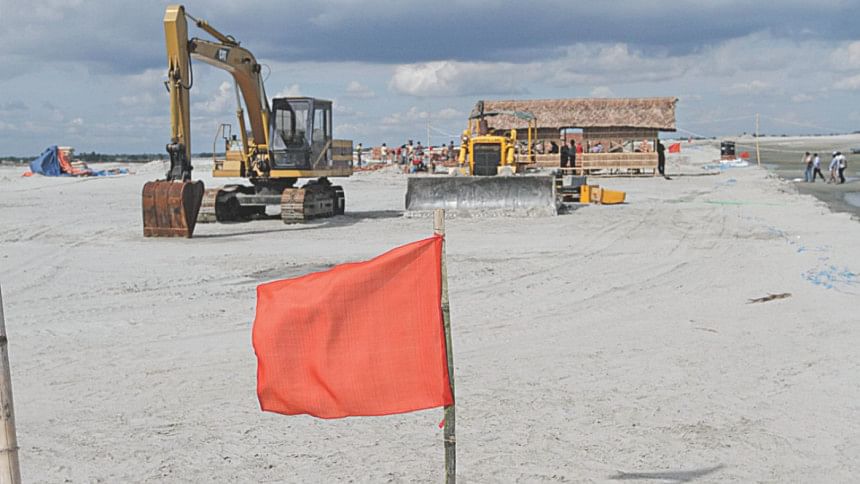Sundarbans in peril


The Sundarbans has been subjected to natural and manmade calamities for many decades. Declared a World Heritage Site by the United Nations, this largest mangrove forest in the world is under threat for many reasons: climate change, temperature increase, salinity intrusion, natural siltation of the river base, illegal resource collection etc.
Salinity intrusion
Some micro-climatic changes are taking place in parts of the Sundarbans. Our seven-year-long study in the Khulna and Satkhira range has found that the increased level of salinity is changing the environment of the area. Due to salinity intrusion, the number of fresh water plants has been decreasing, while high salinity tolerant plants are covering the area. Saline contaminated water and soil can absorb more temperature than the areas where salinity level is low. Thus the temperature in the area is increasing. In addition, due to increased level of salinity, the soil is losing its bonding resulting in land erosion. During high tides, soil erodes which goes to the rivers, canals and creeks, making the river beds higher.
Illegal resource collection
Illegal resource collection is a major threat to the Sundarbans' biodiversity. The forest department's policies and guidelines -- how much resources can be collected per year, which types of resources should not be collected, etc. -- remains mostly unimplemented. The government's direction to collect only Non Timber Forest (NTF) products like honey, wax, Golpata, fuel wood, and Goran sticks is not maintained. The forest department is not capable of monitoring the whole area of the Sundarbans due to lack of infrastructure and manpower. Besides, illegal fishing in the restricted parts of the Sundarbans has led to resource depletion in the forest. What is horrifying is that poison is used by local people to catch fish. Different species of fish come to the canals and creeks inside the forest during their breeding season. The brood fish (mother fish) containing eggs live inside the Sundarbans. Some ocean fish also come here for laying eggs. Thus, rampant use of poison in catching fish poses a serious threat to the large number of fish species living in the rivers and canals of the forest.
Industries around the forest area
The number of multi-purpose projects being established around the Sundarbans is a real cause for concern. Rampal Power Plant, a 1,320 MW coal-fired power plant, is one of them, which is being built some 14 km away from this forest. This power plant will run on coal. As the quality of the coal that will be used by the plant has not yet been defined, we still cannot say how much damage it will do to the environment.
Since the river route inside the Sundarbans will be used for carrying coal for the project, possibility of accidents is high. Although the authorities are saying that a mother vessel will bring the coal to a certain point, which will then be carried to the plant site with small vessels or ships, it is still not clear how they are going to do so. We have seen the disastrous impact on the Sundarbans when oil and coal carrying ships sank in the Shela river.
Furthermore, as the wind flows from north-east to south-west or from north-west to south-east during winter, starting from the end of November till the end February, and there is no rainfall during that time, ultimately, carbon dioxide (CO2), carbon monoxide (CO), sulphur dioxide (SO2), nitrogen dioxide (NO2) and the ashes of this power plant, will flow towards the Sundarbans. Although the EIA report, prepared by the Centre for Environmental and Geographic Information Services (CEGIS), clearly identified this as one of the major problems during the dry season, later the authorities denied that this was a problem saying that the amount of Sulphur Dioxide (SO2), which will increase up to 50 micro-gram per cubic metre, will not be harmful for the forest. The report is flawed because it compared the level of Sulphur (S) and Nitrogen (N) in the Sundarbans with that of the urban areas. Internationally, 30 micro-grams of SO2 per cubic metre is the maximum tolerable level for a forest. At present, the level of SO2 is 18 to 20 micro-grams per cubic metre and NO2 is less than 15 micro-grams per cubic metre. So when the level of sulphur and nitrogen will increase up to 50 micro-grams per cubic metre, the plants and animals will not be able to cope with it. More or less 3,26,49,180 gallons of cooling water will be dumped into the river Passur per day. Similarly, ashes from the plant would be dumped in and around the power plant site, which is the flood plain area of the River Passur. And due to sub-surface leaching of that area, those ashes, containing high level of chemicals such as chromium, cadmium, lead, arsenic, lithium, beryllium, etc., will then be mixed with the surrounding river water, as mentioned in the EIA report. Since this is a tidal area, the contaminated water will ultimately go to the Sundarbans polluting the soil, rivers, canal, and creeks of the Sundarbans.
The EIA report mentioned that the pollutants discharged by the plant will go beyond 25 km of the area. As the Sundarbans is only 14 km away from the plant. So according to their dispersion model, another 11 km of area will be affected. Beside the Karamjal and Mongla Port area, there is a breeding ground and sanctuary of Irrawaddy dolphins, a vulnerable species of dolphin worldwide. Their population will also be affected.
Need for a community-based approach
A community-based approach is more applicable to manage this type of forest. If the local people such as the Mawalis and Bawalis are given the power, Sundarbans can be protected by them. And some of the areas should be declared completely protected where resource collection, entrance of tourists and any other type of human intervention would be totally restricted. If that can be done, natural regeneration of plant and animal varieties will happen in the area.
Shifting all red category industries
If possible, all types of red category industries should be removed from the periphery of the Sundabans. We have a lot of barren lands in Kolapara upazila of Patuakhali, in Amtali, Barguna Sadar and Patharghata upazilas of Barguna, which can be used for establishing the coal based or other power plants. The government has already declared to establish a third port in Paira, which is situated under the Kolpara upazila. The mother vessels can easily use the Rabnabad channel or Paira channel.
Ensuring upstream fresh water flow
The upstream fresh water flow should be ensured, otherwise salinity intrusion will spread. For example, because of the Farakka barrage or drying up of rivers, the upstream water flow is reduced or stopped, especially during the dry season. Thus, the water that flows downstream from the upstream Padma, through Madhumati, Gorai and Baleswar, or in Khulna from Kapotakhkho through Sagardari, cannot come downstream. The result is that during the dry season the salinity level increases and the seeds cannot germinate properly.
Political commitment required for implementing laws
We are a signatory country of the Ramsar Convention and the Convention on Biological Diversity (CBD) and the World Heritage Site. According to these conventions, we are bound to protect all kinds of species inside the Sundarbans, specifically the Royal Bengal Tiger, crocodile, dolphin, deer, otter, Maskfinfut and other species. If we can implement the rules of these three international conventions, as well as our Environmental Act 1995, we can easily protect and solve most of the problems of the Sundarbans.
In order to implement these laws, we need a strong political commitment. No matter which political party is in power, they should never interfere in the implementation process of the international conventions and our rules and regulations. We need an integrated approach with the involvement of different government ministries to save this unique forest from destruction.

 For all latest news, follow The Daily Star's Google News channel.
For all latest news, follow The Daily Star's Google News channel. 



Comments